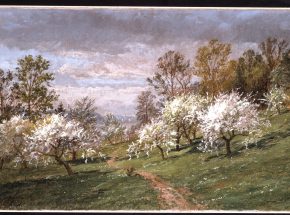

Arthur Wesley Dow was an artist, photographer, and one of this country’s most innovative and influential art educators. For over a thirty-year period, he taught at institutions such as Teachers College at Columbia University, New York City; the Arts Students League, New York City; Pratt Institute, Brooklyn, New York; and his own Ipswich Summer School of Art, Ipswitch, Massachusetts. Many of America’s leading ceramicists, furniture-makers, painters, photographers, and printmakers were Dow’s students, including Georgia O’Keefe, Max Weber, and Edward Steichen.
The ideas about art-making that Dow began to develop in the late 1870s were quite revolutionary for the time. He proposed that copying nature, a process that had formed the basis of academic art instruction for more than 400 years, was at a dead end. In his mind, modern artists should study the elements of composition – line, mass, and color – to come to a “new appreciation of all forms of art and the beauty of nature.”
Dow and his students rejected the then accepted concept that painting and sculpture were of a higher level than the applied arts, such as ceramics, furniture, jewelry, and photography. In their minds, all art forms were of equal value and should be simultaneously beautiful and functional. As such, their work conveys the aesthetic and fundamental premise of the Arts and Crafts movement in America.
http://www.okeeffemuseum.org/visit/exhibitions/dow.html
